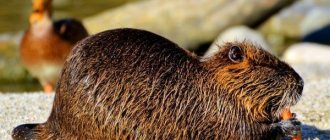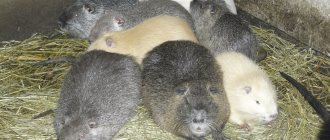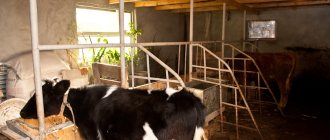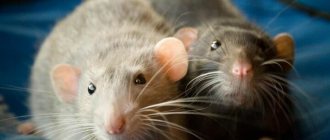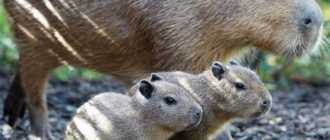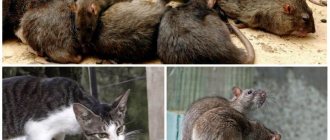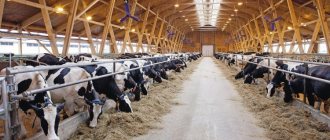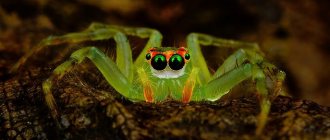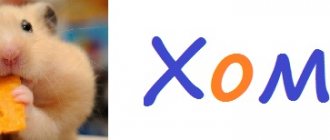When growing nutria, it is necessary to equip a place for the animals to live. Breeding nutria in cages is the most economical way to organize space. The cells take up little space and are suitable for long-term use. You can purchase them or design them yourself. In a detailed analysis of which cages are most suitable for nutria, it is important to take into account the physiological characteristics of the animals, their feeding needs, frequency of cleaning, and other nuances.
Characteristics of animals
How to make cages for nutria directly depends on the local climate. It is necessary to take into account regional differences, since nutria may suffer from improper organization of living conditions, and this is due to its physiological characteristics. Some of them are worth focusing on:
- Thermophilia . When the temperature on the thermometer drops to minus levels, nutria can get frostbite on their legs, tails, and faces. Newborn puppies die when conceived already at +8°C. If you do not increase the temperature in the room where the nutria live, they lose weight, bury themselves in the litter, spend time half asleep and may die.
- Nutria are rodents ; they chew through almost everything they see. It can be wood, plastic, soft metal. To preserve the internal structure, it must be edged with a metal corner, galvanized sheet, or mesh. If the walls are made of wood or plywood, and at the same time have a flat surface, the nutria will not be interested in them, but it is better to cover all protruding parts (slats, corners).
- The need for plant foods and clean water . The average water requirement of nutria is 500 ml per day, but provided that the animals are fed dry food. When feeding wet food, water will be required approximately 2 times less.
- Love for water . Nutria have waterproof fur and are semi-aquatic animals, so swimming pools are specially equipped for them. However, on large farms they practice cultivation in an anhydrous mode (without bathing), which does not affect the quality of the skins and the rate of weight gain. In private households, they adhere to the following schedule: in winter - anhydrous regime, in summer - bathing. In winter, even in a warm room when equipping a swimming pool, air humidity increases, which leads to an increase in the incidence of young animals.
Nutria actively drink water not only from drinking bowls, but also from the pool, so it must be regularly replaced with fresh water.
The physiological needs of animals must and can be satisfied under artificial breeding conditions.
Why breed nutria?
In the photo: the insides of a member of our portal 4cus.
Some time ago, nutria were profitable to keep because of their valuable skins.
Mityai FORUMHOUSE Member
We kept nutria from 1974 to 2002, my father and I stored hay for the winter, and my mother sewed hats from September to February. The livestock reached 250 pieces, it was quite difficult, especially when cleaning enclosures and cages. But thanks to the sale of hats, they built a house of 180 sq.m.
But the value of nutria is not only in their skins, but also in meat, which is considered dietary. It is in no way inferior to rabbit meat and is very similar to it.
About the taste of meat: the meat of both is tasty and dietary, and not everyone can tell by taste which is nutria and which is rabbit. According to reviews from members of our portal who are seriously involved in nutria farming, a cut male carcass at the age of 7-8 months weighs approximately 3.5 kg, a female carcass is slightly lighter.
4cus Member FORUMHOUSE
I don’t remember the maximum weight, 5-6 kg, maybe more. But I remember that the carcass of a Yurlov rooster of the same age was 4.5 kg! I plan to give the skins to people who do this.
The fertility of nutria is significantly lower than that of rabbits, but it is quite possible to provide your family with meat and still sell the surplus. In addition, nutria get sick much less often than rabbits.
Cell sizes
To make cages for nutria with your own hands, take drawings, the dimensions of which are developed according to the standards:
- height from the ground is approximately 0.7 m;
- the distance between the floor covering and the highest point is 0.6 m;
- compartment height - about 0.5 m;
- cage length - 2.8 m;
- the width of the opening with the door for walking is about 0.6 m;
- the thickness of the scrap serving as a support for the cage is from 10 mm.
One cage of the indicated sizes with an equipped walking area is intended to support 1 family, including a male, 2-4 females and offspring. Subsequently, the growing young animals are moved to separate multi-level houses.
Cages for nutria at home are made of plywood or plastic, but it is necessary to provide a protective mesh, otherwise the nutria will make holes in the walls. When arranging ground cells, you should take into account that nutria are excellent at digging the ground, so the mesh is deepened by 0.5 m.
The feeding compartment is located between the nesting compartment and the walking area. Animals enter it through a hole measuring 25x25 cm or 30x30 cm.
The size of the paddock is determined taking into account the available free space and has a length of 1-3 m and a width of 0.7 to 1.5 m. The paddock must be equipped with fences at least 0.8 m high, otherwise an additional canopy will have to be installed.
The pool is equipped after the walking area, its depth is from 40 cm. An important condition for installing a pool is the ability to constantly change the water.
When building a cage for nutria with your own hands, a drawing and diagram will help:
Pool
The presence of a swimming pool in the nutria walking area is, if not mandatory, then very desirable. After all, these animals are waterfowl, and the absence of a body of water negatively affects their psychological and physical health. Nutria that are kept exclusively in cages may exhibit restless behavior, have duller fur, and have trouble gaining weight.
The pool is equipped only for the warm season. To do this, choose a large container in which you need to change the water regularly. Pools with high sides can be dug into the ground so that nutria can easily enter the water. Most often, old bathtubs are used as containers in personal plots.
Making your own house
The cage must be designed taking into account the number of animals and the expected offspring. To build a cage you will need:
- supports in the form of pipes made of concrete (4 pcs.) and metal (5 pcs.);
- metal mesh with a mesh size of 25 mm and a wire thickness of 5-6 m;
- material to provide thermal insulation;
- plywood;
- flat slate for the roof;
- galvanized metal sheet;
- cement;
- sand;
- welding machine and electrodes, screwdriver, grinder.
Schematically, the work on building a cell looks like this:
1. House 2. Floor net 3. Wooden frame 4. Feed compartment floor 5. Pool (trough) 6. Removable rear grille 7. Roof over the walking area 8. Door 9. Grate over the walking area 10. Removable cover 11. Side grill
You need to act according to the instructions:
- Install supports. The basis will be concrete pipes, which should be dug into the ground to a depth of at least 1 m. Secure the pipes by filling the holes with cement mortar.
- Construct the frame. To do this, you can use one of the methods. The first is to make individual cells. Make 3-layer sandwich panels. They are frames with slats inside. Sheet insulation is attached to the slats, and the outside of the frame is upholstered with wood or plywood. A house with insulation is suitable for wintering nutria, but if the climate in the region assumes constant above-zero temperatures, insulation is not required. The second method of making cells involves the active use of a welding machine, that is, it is more difficult to make such structures with your own hands. Using it, first weld the metal pipes to the supports, and then weld the mesh to the supports. It forms the inner covering of the cell. On the outside, a frame made of plywood or wood is attached to the supports. Screws are used as fasteners. For insulation, it is necessary to attach sheets of polystyrene foam on top of the plywood, and then cover the structure again with a layer of galvanized metal or wood.
- Fasten the 3 manufactured panels in the form of the letter “P”; the fourth panel will be the grid.
- Install the roof using hinge joints. The folding top will make caring for animals easier.
In summer, the recreation area with a swimming pool is filled with water. Above it should be installed not a mesh, but a solid covering to form a shadow.
In regions with warm climates, houses can be installed outdoors or in an unheated room. If the temperature in the breeding region drops below +10°C, a cooking and heating stove should be constructed in the room. This type of heating is convenient and economical. As the mash cooks, the room will become drier and warmer.
Conclusion
The proposed cage maintains a comfortable temperature well in both summer and winter. You need to install a container with water for bathing in it. Fine mesh on the walls prevents the plywood from being chewed. All materials are light enough, and even one person can carry the empty cage by removing the roof.
If the female living in it gives birth, then it is enough to install a drawer from a desk or cabinet in the far corner. This will be enough for her to build a nice and warm nest for the babies, and she can watch them without opening the door.
Types of cells
Cells excited for the summer and winter periods are significantly different. In addition, the dwelling can be built in a classical form, have a multi-tiered structure, or be fenced in the form of an enclosure.
Cells also differ depending on who will live in them:
- females and males for reproduction;
- nutria for slaughter;
- growing individuals.
Making cages for nutria with your own hands is necessary, taking into account the age and status of the individuals. The strongest, hardiest nutrias with good breed characteristics are placed in separate houses, where they form a family. Such cages are equipped with a nesting compartment with soft bedding. Floors are made of concrete or tin to facilitate disinfection. The house itself is located in a warm place.
There are many options, but how to make a cage for nutria, and which one will be better, remains to be figured out.
Summer aviary
Such options are suitable for installation only in regions with a warm climate, where even at night the temperature does not drop below +10°C. The structures are built directly on the street, and from each cell there is access to a swimming pool. An alternative to a pool can be a shower. Nutria need to turn on the water twice a day, the bathing period takes up to half an hour.
For relaxation on hot days, there are houses on the territory of the enclosure, the roofs of which are covered with material that does not allow the sun's rays to pass through.
If it is necessary to separate pregnant females and young animals, several enclosures are set up simultaneously.
The arrangement of cages for nutria in an enclosure is standard, consisting of a feeder, a nesting compartment, and a pool. All drinkers and feeders are securely fixed to the walls of the cage.
Ground houses
Installing the house directly on the ground is suitable for keeping nutria in warm regions. Brick and stone are used to build walls. It is advisable to fix the mesh from the inside by digging it into the ground to a depth of 50 cm. The house is equipped with a closed or open walk. It should have a slight slope/slope towards the pool.
Housing made of stone is cold, and if nutria are bred in the northern regions, then such houses are installed in a barn-type room, and a manhole leads from the house to the street. When it gets cold, the hole is covered, and the nutria remain in a warm barn.
Portable cages
Portable housing consists of 2 compartments - for feeding and for living. In the summer, cages are installed in an enclosure. The latter is formed from a mesh buried 0.5 m into the ground.
When it gets colder, wooden houses can be moved from the enclosure to an insulated barn.
Multi-tiered houses
As the population increases, multi-tier cages are installed. They are structures consisting of 2-3 tiers. Each of the tiers has its own walking area, and each cage is equipped with a feeding trough. To create a nutria cage with your own hands at home, you can use the following diagram:
It is advisable to place the houses not on the floor, but on strong metal supports.
Blocks consisting of 3 tiers are usually built from galvanized mesh. Their height is about 1 m, and their width is 1.5 m. The block is divided into equal-sized compartments with paddocks, pens, feeders and drinking bowls. Each of these compartments is designed for 6 heads.
Photo of a homemade nutria cage:
Multi-tiered structures provide enough space for young animals to grow and be active. Individuals living in spacious cages are distinguished by good quality fur.
Budget options
Rodents often live in cages designed for keeping foxes and rabbits. These cages are sold in pet stores. When choosing, you need to consider the following points:
- Material. It must be as durable as possible. For wintering animals, cages with insulation are purchased.
- Number of sections.
- Design size: length - about 1 m, width - up to 65 cm, and height - from 55 cm.
Purchased cages are placed in a barn or enclosure. They can be easily carried if necessary.
When nutria are kept in cages, a bathing area is provided for them. An impromptu pool can be a trough made of metal or any waterproof, stainless and durable material. Its edges must be processed and absolutely safe. The pool must be installed at an angle so that the descent into it is as smooth as possible.
Knowing how to make a nutria cage with your own hands, you can save money when increasing the number of livestock. It will be enough to add tiers to the structure or make extensions, having previously developed drawings of cages for nutria.
Primary requirements
Nutria are rodents that chew everything in their path, including cells if they are made of wood. By placing a nutria in a wooden cage, you risk being left without the animal, as it will simply escape through the hole it has gnawed in the cage. Therefore, these animals should only be locked in cages made of metal rods.
The cage for keeping nutria must meet the following requirements:
- The walls of the cage should be made of metal mesh or lattice with small cells. Such a structure will provide the nutria with a sufficient amount of oxygen and give the breeder the opportunity to observe.
- The covering of the base of the cage can be either solid or lattice. When choosing the last option, make sure that the animals cannot get hurt.
- When letting animals out for a walk, eliminate all possibilities of escape. This is achieved by fencing the area.
- The length of the cage should not be less than 250 cm.
- During the cold season, the cage must be insulated. It is advisable that it be disassembled, so you can easily move it to a warm place.
- The cage must contain a pool, which is necessary for the health of the nutria and high-quality fur.
If the animal successfully escapes, know that you should look for it near the nearest body of water. Don't forget to take bait in the form of juicy fruits.
Benefits of Breeding
Growing nutria is very profitable for several reasons. Firstly, animal meat has a high nutritional value and has a wonderful taste. The meat is quickly and easily digestible, classified as dietary, very tender and tasty.
In addition to meat, nutria's fur is also highly valued. The skins, which have a glossy shine, are widely used in furriery: they are used to make hats and warm fur coats. Nutria, among other things, are highly fertile. With proper care and adequate feeding, the livestock grows rapidly. You may also be interested in what is the gestation period for rabbits.
Choosing a breed
Growing nutria for their skins forces the farm owner to pay attention to the color of the animals. There are two types of animals that are bred at home: standard and colored.
- Standard nutria are practically no different from their wild relatives. They are easy to care for and not picky about food. Females have a pronounced maternal instinct and are caring for their offspring. The nature of the animals is calm. The fur color of the animals is “wild” - brown, brown (light and dark), black.
- Colored nutria have different fur colors: white, fawn, red. Animals require comfortable living conditions and a balanced diet.
Colored nutria are divided into two types based on the principle of color inheritance: dominant and recessive. Dominant colors include:
- golden - light yellow coat color that shimmers beautifully in the sun;
- black is the most expensive fur on the market;
- white - the color creates the illusion of a thicker pile on the skin than it actually is.
The recessive group of colors includes:
- pearlescent color of the skin, which can be obtained by crossing beige and white animals;
- cream color - characteristic of the white Italian breed;
- beige - can have different shades: sand, silver, cream.
Obtaining colored nutria requires knowledge in the field of genetics and the characteristics of the inheritance of color in offspring.
Barn for a small family
If you support one family, then a small structure that you build with your own hands is enough. If you have several families, you may need a more substantial structure. Also, the barn needs to be built taking into account the fact that your herd may grow in the future. A room measuring 6x5x2.5 m can comfortably accommodate several families.
Barn with paddocks
It is best to build a shed from cinder blocks. This is not only the most affordable material, but also retains heat very well. The inside of the building can be insulated with polystyrene foam and then covered with mesh or metal sheets. Otherwise, animals may simply chew it.
Shell rock or brick are also good materials; in any case, the choice of what exactly to build a home for your charges from is entirely yours.
The room must have a window and an entrance door. It would not be superfluous to arrange a hatch through which manure will be thrown out. It is better to have concrete floors. The walls and ceiling need to be insulated, the roof covered with slate or sheet iron.
